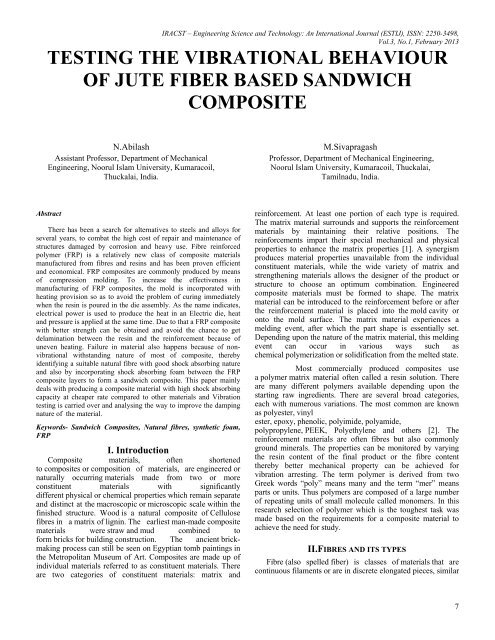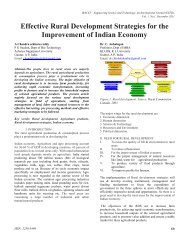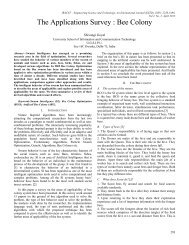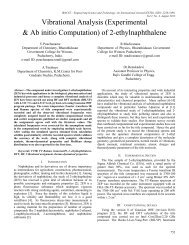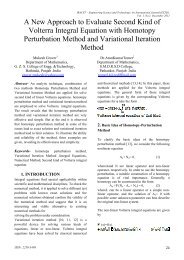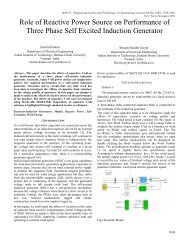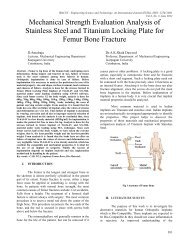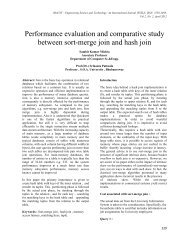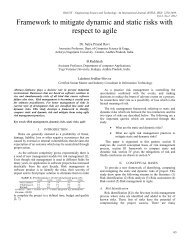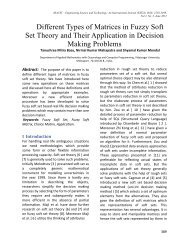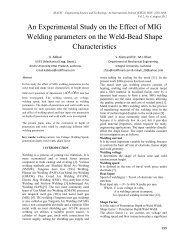testing the vibrational behaviour of jute fiber based sandwich ...
testing the vibrational behaviour of jute fiber based sandwich ...
testing the vibrational behaviour of jute fiber based sandwich ...
Create successful ePaper yourself
Turn your PDF publications into a flip-book with our unique Google optimized e-Paper software.
IRACST – Engineering Science and Technology: An International Journal (ESTIJ), ISSN: 2250-3498,Vol.3, No.1, February 2013TESTING THE VIBRATIONAL BEHAVIOUROF JUTE FIBER BASED SANDWICHCOMPOSITEN.AbilashAssistant Pr<strong>of</strong>essor, Department <strong>of</strong> MechanicalEngineering, Noorul Islam University, Kumaracoil,Thuckalai, India.M.SivapragashPr<strong>of</strong>essor, Department <strong>of</strong> Mechanical Engineering,Noorul Islam University, Kumaracoil, Thuckalai,Tamilnadu, India.AbstractThere has been a search for alternatives to steels and alloys forseveral years, to combat <strong>the</strong> high cost <strong>of</strong> repair and maintenance <strong>of</strong>structures damaged by corrosion and heavy use. Fibre reinforcedpolymer (FRP) is a relatively new class <strong>of</strong> composite materialsmanufactured from fibres and resins and has been proven efficientand economical. FRP composites are commonly produced by means<strong>of</strong> compression molding. To increase <strong>the</strong> effectiveness inmanufacturing <strong>of</strong> FRP composites, <strong>the</strong> mold is incorporated withheating provision so as to avoid <strong>the</strong> problem <strong>of</strong> curing immediatelywhen <strong>the</strong> resin is poured in <strong>the</strong> die assembly. As <strong>the</strong> name indicates,electrical power is used to produce <strong>the</strong> heat in an Electric die, heatand pressure is applied at <strong>the</strong> same time. Due to that a FRP compositewith better strength can be obtained and avoid <strong>the</strong> chance to getdelamination between <strong>the</strong> resin and <strong>the</strong> reinforcement because <strong>of</strong>uneven heating. Failure in material also happens because <strong>of</strong> non<strong>vibrational</strong>withstanding nature <strong>of</strong> most <strong>of</strong> composite, <strong>the</strong>rebyidentifying a suitable natural fibre with good shock absorbing natureand also by incorporating shock absorbing foam between <strong>the</strong> FRPcomposite layers to form a <strong>sandwich</strong> composite. This paper mainlydeals with producing a composite material with high shock absorbingcapacity at cheaper rate compared to o<strong>the</strong>r materials and Vibration<strong>testing</strong> is carried over and analysing <strong>the</strong> way to improve <strong>the</strong> dampingnature <strong>of</strong> <strong>the</strong> material.Keywords- Sandwich Composites, Natural fibres, syn<strong>the</strong>tic foam,FRPI. IntroductionComposite materials, <strong>of</strong>ten shortenedto composites or composition <strong>of</strong> materials, are engineered ornaturally occurring materials made from two or moreconstituent materials with significantlydifferent physical or chemical properties which remain separateand distinct at <strong>the</strong> macroscopic or microscopic scale within <strong>the</strong>finished structure. Wood is a natural composite <strong>of</strong> Cellulosefibres in a matrix <strong>of</strong> lignin. The earliest man-made compositematerials were straw and mud combined t<strong>of</strong>orm bricks for building construction. The ancient brickmakingprocess can still be seen on Egyptian tomb paintings in<strong>the</strong> Metropolitan Museum <strong>of</strong> Art. Composites are made up <strong>of</strong>individual materials referred to as constituent materials. Thereare two categories <strong>of</strong> constituent materials: matrix andreinforcement. At least one portion <strong>of</strong> each type is required.The matrix material surrounds and supports <strong>the</strong> reinforcementmaterials by maintaining <strong>the</strong>ir relative positions. Thereinforcements impart <strong>the</strong>ir special mechanical and physicalproperties to enhance <strong>the</strong> matrix properties [1]. A synergismproduces material properties unavailable from <strong>the</strong> individualconstituent materials, while <strong>the</strong> wide variety <strong>of</strong> matrix andstreng<strong>the</strong>ning materials allows <strong>the</strong> designer <strong>of</strong> <strong>the</strong> product orstructure to choose an optimum combination. Engineeredcomposite materials must be formed to shape. The matrixmaterial can be introduced to <strong>the</strong> reinforcement before or after<strong>the</strong> reinforcement material is placed into <strong>the</strong> mold cavity oronto <strong>the</strong> mold surface. The matrix material experiences amelding event, after which <strong>the</strong> part shape is essentially set.Depending upon <strong>the</strong> nature <strong>of</strong> <strong>the</strong> matrix material, this meldingevent can occur in various ways such aschemical polymerization or solidification from <strong>the</strong> melted state.Most commercially produced composites usea polymer matrix material <strong>of</strong>ten called a resin solution. Thereare many different polymers available depending upon <strong>the</strong>starting raw ingredients. There are several broad categories,each with numerous variations. The most common are knownas polyester, vinylester, epoxy, phenolic, polyimide, polyamide,polypropylene, PEEK, Polyethylene and o<strong>the</strong>rs [2]. Thereinforcement materials are <strong>of</strong>ten fibres but also commonlyground minerals. The properties can be monitored by varying<strong>the</strong> resin content <strong>of</strong> <strong>the</strong> final product or <strong>the</strong> fibre content<strong>the</strong>reby better mechanical property can be achieved forvibration arresting. The term polymer is derived from twoGreek words “poly” means many and <strong>the</strong> term “mer” meansparts or units. Thus polymers are composed <strong>of</strong> a large number<strong>of</strong> repeating units <strong>of</strong> small molecule called monomers. In thisresearch selection <strong>of</strong> polymer which is <strong>the</strong> toughest task wasmade <strong>based</strong> on <strong>the</strong> requirements for a composite material toachieve <strong>the</strong> need for study.II.FIBRES AND ITS TYPESFibre (also spelled <strong>fiber</strong>) is classes <strong>of</strong> materials that arecontinuous filaments or are in discrete elongated pieces, similar7
IRACST – Engineering Science and Technology: An International Journal (ESTIJ), ISSN: 2250-3498,Vol.3, No.1, February 2013to lengths <strong>of</strong> thread. They are very important in <strong>the</strong> biology <strong>of</strong>FIG.1 (FIBRE CLASSIFICATION)both plants and animals, for holding tissues toge<strong>the</strong>r. Humanuses for fibres are diverse. This can be spuninto filaments, string, or rope, used as a component<strong>of</strong> composite materials, or matted into sheets to make productssuch as paper or felt [3]. Fibres are <strong>of</strong>ten used in <strong>the</strong>manufacture <strong>of</strong> o<strong>the</strong>r materials. The strongest engineeringmaterials are generally made as fibres, for example carbonfibre and Ultra-high-molecular-weight polyethylene. Syn<strong>the</strong>ticfibres can <strong>of</strong>ten be produced very cheaply and in large amountscompared to natural fibres, but for clothing natural fibres cangive some benefits, such as comfort, over <strong>the</strong>ir syn<strong>the</strong>ticcounterparts. Classification <strong>of</strong> fibres is shown in Fig.1A. Natural FibresNatural fibres include those produced by plants, animals,and geological processes. They are biodegradable over time[4]. They can be classified according to <strong>the</strong>ir origin:Vegetable fibres are generally <strong>based</strong> on arrangements<strong>of</strong> cellulose; <strong>of</strong>ten with lignin examplesinclude cotton, hemp, <strong>jute</strong>, flax, ramie, and sisal. Plant fibresare employed in <strong>the</strong> manufacture <strong>of</strong> paper and textile (cloth),and dietary fibre is an important component <strong>of</strong> human nutrition.Wood fibre, distinguished from vegetable fibre, is from treesources. Forms include groundwood, <strong>the</strong>rmo mechanical pulp(TMP) and bleached or unbleached kraft or sulfite pulps. Kraftand sulfite, also called sulphite, refer to <strong>the</strong> type <strong>of</strong> pulpingprocess used to remove <strong>the</strong> lignin bonding <strong>the</strong> original woodstructure, thus freeing <strong>the</strong> fibres for use in paperand engineered wood products such as fibre board.Animal fibres consist largely <strong>of</strong> particular proteins.Instances are spider silk, sinew, catgut, wool and hair such ascashmere, mohair and angora, fur such as sheepskin, rabbit,mink, fox, beaver, etc.Mineral fibres include <strong>the</strong> asbestos group. Asbestos is <strong>the</strong>only naturally occurring long mineral fibre. Six minerals havebeen classified as "asbestos" including chrysotile <strong>of</strong><strong>the</strong> serpentine class and those belonging to<strong>the</strong> amphibole class: amosite, crocidolite, tremolite, anthophyllite and actinolite. Short, fibre-like mineralsinclude wollastonite and attapulgite.B. Syn<strong>the</strong>tic FibresSyn<strong>the</strong>tic fibres are manufactured from natural cellulose,including rayon, modal, and Lyocell. Cellulose-<strong>based</strong> fibres are<strong>of</strong> two types, regenerated or pure cellulose such as from <strong>the</strong>cupro-ammonium process and modified cellulose such as <strong>the</strong>cellulose acetates [5]. Fibre classification in reinforced plasticsfalls into two classes: (i) short fibres, also known asdiscontinuous fibres, with a general aspect ratio (defined as <strong>the</strong>ratio <strong>of</strong> fibre length to diameter) between 20 to 60, and (ii) longfibres, also known as continuous fibres; <strong>the</strong> general aspect ratiois between 200 to 500.III.THE DIFFERENCE BETWEEN NATURAL ANDSYNTHETIC FIBRESA. Natural Fibre PropertiesNatural fibres are obtained from plants or animals. It is anenvironmentally friendly choice for sewing projects because<strong>the</strong> fabric is created from renewable resources. Cotton, linen,wool, and silk are fabrics made with natural fibres The mostcommon types <strong>of</strong> animals used in created natural fibre fabricsare sheep, alpacas, and silkworm, but o<strong>the</strong>r animals like goatsand rabbits are also used. There is a variety <strong>of</strong> different plantsused in creating natural fabrics. Cotton is, by far, <strong>the</strong> mostcommonly used plant in making natural fabric [6]. Bamboo isbecoming increasingly popular because <strong>of</strong> its fast rate <strong>of</strong>renewal. O<strong>the</strong>r plants used in creating natural fabrics are flax,hemp, and pineapple leaves [7].B. Syn<strong>the</strong>tic Fibre PropertiesSyn<strong>the</strong>tic fibres are a man-made product created through achemical process. Chemicals are forced into spinnerets, whichhave tiny holes where <strong>the</strong> syn<strong>the</strong>tic fibres are created. Polyesteris <strong>the</strong> most common syn<strong>the</strong>tic fabric created, but <strong>the</strong>re is a hugelist <strong>of</strong> o<strong>the</strong>r man-made fabrics. Acetate, nylon, and spandex arecommonly used syn<strong>the</strong>tic fabrics. Syn<strong>the</strong>tic fabrics have a hugeadvantage over natural fabrics because <strong>the</strong>y are more durable[8]. Natural fabrics, however, are better for beginners because<strong>the</strong>y are easier to sew on. In general, <strong>the</strong> type <strong>of</strong> project shouldbe taken into consideration before deciding whe<strong>the</strong>r a naturalor syn<strong>the</strong>tic fabric should be used.IV. CHARACTERISTICS OF NATURAL ANDSYNTHETIC FABRIC BLENDSAs its name would suggest, fabric blends are created bycombining a natural fibre with a syn<strong>the</strong>tic fibre. Using fabricthat is created by combining two types <strong>of</strong> fibres is a great wayto get <strong>the</strong> exact look or feel desired in a fabric. Natural fibrescan feel scratchy to <strong>the</strong> skin but provide a lot <strong>of</strong> warmth.Combining a natural fibre with a syn<strong>the</strong>tic fibre can give <strong>the</strong>8
fabric durability, warmth, comfort, aes<strong>the</strong>tic appeal, sheen, orany o<strong>the</strong>r number <strong>of</strong> combined qualities. Many different types<strong>of</strong> fabric blends are easily found in fabric stores. Cotton-polyblends are <strong>the</strong> most common and are a great choice for mostsewing projects. Fabric blends, in general, are easier to takecare <strong>of</strong> than natural or syn<strong>the</strong>tic fibres on <strong>the</strong>ir own. Thisblending <strong>of</strong> fibres is called as hybrid fibres.V.Composite and its classificationThe term composite can be defined as a material composed<strong>of</strong> two or more different materials, with <strong>the</strong> properties <strong>of</strong> <strong>the</strong>resultant material being superior to <strong>the</strong> properties <strong>of</strong> <strong>the</strong>individual material that make up <strong>the</strong> composite. The two majorclassifications <strong>of</strong> composites are natural and syn<strong>the</strong>tic. Figure 2shows <strong>the</strong> three major classifications <strong>of</strong> composite materials.The most widely used meaning is <strong>the</strong> following one, which hasbeen stated by, Jartiz “Composites are multifunctional materialsystems that provide characteristics not obtainable from anydiscrete material. They are cohesive structures made byphysically combining two or more compatible materials,different in composition and characteristics and sometimes inform”. The weakness <strong>of</strong> this definition resided in <strong>the</strong> fact that itallows one to classify among <strong>the</strong> composites any mixture <strong>of</strong>materials without indicating ei<strong>the</strong>r its specificity or <strong>the</strong> lawswhich should given it which distinguishes it from o<strong>the</strong>r verybanal, meaningless mixtures. Kelly very clearly stresses that<strong>the</strong> composites should not be regarded simple as a combination<strong>of</strong> two materials. In <strong>the</strong> broader significance; <strong>the</strong> combinationhas its own distinctive properties. In terms <strong>of</strong> strength toresistance to heat or some o<strong>the</strong>r desirable quality, it is betterthan ei<strong>the</strong>r <strong>of</strong> <strong>the</strong> components alone or radically different fromei<strong>the</strong>r <strong>of</strong> <strong>the</strong>m. Beghezan defines as “The composites arecompound materials which differ from alloys by <strong>the</strong> fact that<strong>the</strong> individual components retain <strong>the</strong>ir characteristics but are soincorporated into <strong>the</strong> composite as to take advantage only <strong>of</strong><strong>the</strong>ir attributes and not <strong>of</strong> <strong>the</strong>ir short comings”, in order toobtain improved materials. Van Suchetclan explains compositematerials as heterogeneous materials consisting <strong>of</strong> two or moresolid phases, which are in intimate contact with each o<strong>the</strong>r on amicroscopic scale. They can be also considered ashomogeneous materials on a microscopic scale in <strong>the</strong> sense thatany portion <strong>of</strong> it will have <strong>the</strong> same physical property.Broadly,composite materials can be classified into three groups on <strong>the</strong>basis <strong>of</strong> matrix material. They are: Metal Matrix Composites(MMC), Ceramic Matrix Composites (CMC), and PolymerMatrix Composites (PMC)A. Metal Matrix CompositesMetal Matrix Composites have many advantages overmonolithic metals like higher specific modulus, higher specificstrength, better properties at elevated temperatures, and lowercoefficient <strong>of</strong> <strong>the</strong>rmal expansion. Because <strong>of</strong> <strong>the</strong>se attributesmetal matrix composites are under consideration for widerange <strong>of</strong> applications viz. combustion chamber nozzle (inrocket, space shuttle), housings, tubing, cables, heatexchangers, structural members etc.B. Ceramic matrix CompositesIRACST – Engineering Science and Technology: An International Journal (ESTIJ), ISSN: 2250-3498,Vol.3, No.1, February 2013One <strong>of</strong> <strong>the</strong> main objectives in producing ceramic matrixcomposites is to increase <strong>the</strong> toughness. Naturally it is hopedand indeed <strong>of</strong>ten found that <strong>the</strong>re is a concomitantimprovement in strength and stiffness <strong>of</strong> ceramic matrixcomposites [9].C. Polymer matrix CompositesMost commonly used matrix materials are polymeric. Thereasons for this are tw<strong>of</strong>old. In general <strong>the</strong> mechanicalproperties <strong>of</strong> polymers are inadequate for many structuralpurposes. In particular <strong>the</strong>ir strength and stiffness are lowcompared to metals and ceramics. These difficulties areovercome by reinforcing o<strong>the</strong>r materials with polymers.Secondly <strong>the</strong> processing <strong>of</strong> polymer matrix composites neednot involve high pressure and does not require hightemperature. Also equipments required for manufacturingpolymer matrix composites are simpler. For this reasonpolymer matrix composites developed rapidly and soon becamepopular for structural applications. Composites are usedbecause overall properties <strong>of</strong> <strong>the</strong> composites are superior tothose <strong>of</strong> <strong>the</strong> individual components for examplepolymer/ceramic. Composites have a greater modulus than <strong>the</strong>polymer component but are not as brittle as ceramics.Fig.2 classifications <strong>of</strong> composite materialsVI. Natural Fibre Reinforced CompositesThe interest in natural fibre-reinforced polymer compositematerials is rapidly growing both in terms <strong>of</strong> <strong>the</strong>ir industrialapplications and fundamental research. They are renewable,cheap, completely or partially recyclable, and biodegradable.Plants, such as flax, cotton, hemp, <strong>jute</strong>, sisal, kenaf, pineapple,ramie, bamboo, banana, etc., as well as wood, used from timeimmemorial as a source <strong>of</strong> lingo cellulosic fibres, are more andmore <strong>of</strong>ten applied as <strong>the</strong> reinforcement <strong>of</strong> composites. Theiravailability, renewability, low density, and price as well assatisfactory mechanical properties make <strong>the</strong>m an attractiveecological alternative to glass, carbon and man-made fibresused for <strong>the</strong> manufacturing <strong>of</strong> composites [10]. The naturalfibre-containing composites are more environmentally friendly,and are used in transportation (automobiles, railway coaches,9
IRACST – Engineering Science and Technology: An International Journal (ESTIJ), ISSN: 2250-3498,Vol.3, No.1, February 2013aerospace), military applications, building and constructionindustries (ceiling panelling, partition boards), packaging,consumer products, etc.A. Jute FibreJute is a long, s<strong>of</strong>t, shiny vegetable fibre that can be spuninto coarse, strong threads. It is produced from plants in <strong>the</strong>genus Corchorus, which has been classified in <strong>the</strong>family Tiliaceae, or more recently in Malvaceae. Jute is one <strong>of</strong><strong>the</strong> most affordable natural fibres and is second onlyto cotton in amount produced and variety <strong>of</strong> uses <strong>of</strong> vegetablefibresUses <strong>of</strong> Jute: Jute is <strong>the</strong> second most important vegetablefibre after cotton; not only for cultivation, but also for varioususes. Jute is used chiefly to make cloth for wrapping bales <strong>of</strong>raw cotton, and to make sacks and coarse cloth. The fibres arealso woven into curtains, chair coverings, carpets, area rugs,hessian cloth, and backing for linoleum. While <strong>jute</strong> is beingreplaced by syn<strong>the</strong>tic materials in many <strong>of</strong> <strong>the</strong>se uses, someuses take advantage <strong>of</strong> <strong>jute</strong>'s biodegradable nature, wheresyn<strong>the</strong>tics would be unsuitable [11]. Examples <strong>of</strong> such usesinclude containers for planting young trees, which can beplanted directly with <strong>the</strong> container without disturbing <strong>the</strong> roots,and land restoration where <strong>jute</strong> cloth prevents erosion occurringwhile natural vegetation becomes established. The fibres areused alone or blended with o<strong>the</strong>r types <strong>of</strong> fibre tomake twine and rope. Jute rope has long been popularin Japan for use in bondage. Jute butts, <strong>the</strong> coarse ends <strong>of</strong> <strong>the</strong>plants, are used to make inexpensive cloth. Conversely, veryfine threads <strong>of</strong> <strong>jute</strong> can be separated out and madeinto imitation silk. As <strong>jute</strong> fibres are also being used to makepulp and paper, and with increasing concern over forestdestruction for <strong>the</strong> wood pulp used to make most paper, <strong>the</strong>importance <strong>of</strong> <strong>jute</strong> for this purpose may increase. Jute has along history <strong>of</strong> use in <strong>the</strong> sackings, carpets, wrapping fabrics(cotton bale), and construction fabric manufacturing industry[12].Traditionally <strong>jute</strong> was used in traditional textilemachineries as textile fibres having cellulose (vegetable fibrecontent) and lignin (wood fibre content). But, <strong>the</strong> majorbreakthrough came when <strong>the</strong> automobile, pulp and paper, and<strong>the</strong> furniture and bedding industries started to use <strong>jute</strong> and itsallied fibres with <strong>the</strong>ir non-woven and composite technology tomanufacture nonwovens, technical textiles, and composites.Therefore, <strong>jute</strong> has changed its textile fibre outlook and steadilyheading towards its newer identity, i.e., wood fibre. As a textilefibre, <strong>jute</strong> has reached its peak from where <strong>the</strong>re is no hope <strong>of</strong>progress, but as a wood fibre <strong>jute</strong> has many promising features.Figure 3 and 4 shows <strong>the</strong> images <strong>of</strong> <strong>jute</strong> plant and knitted <strong>jute</strong>fabric. Jute is used in <strong>the</strong> manufacture <strong>of</strong> a number <strong>of</strong> fabricssuch as Hessian cloth, sacking, scrim, carpet backing cloth(CBC), and canvas. Hessian, lighter than sacking, is used forbags, wrappers, wall-coverings, upholstery, and homefurnishings. Sacking, a fabric made <strong>of</strong> heavy <strong>jute</strong> fibres, has itsuse in <strong>the</strong> name. CBC made <strong>of</strong> <strong>jute</strong> comes in two types.Primary CBC provides a tufting surface, while secondary CBCis bonded onto <strong>the</strong> primary backing for an overlay. Jutepackaging is used as an eco-friendly substitute.Fig. 3 Jute plantVII. How Fabric is madeFig. 4 Knitted Jute fabricNatural, syn<strong>the</strong>tic, and fabric blends are all created in asimilar way. Fabric is woven, non-woven or knit. Wovenfabrics are <strong>the</strong> most durable, nonwoven fabrics are usually <strong>the</strong>least expensive, and knit fabrics are <strong>the</strong> most comfortable towear. Woven – There are three different types <strong>of</strong> weaves usedin woven fabrics, and <strong>the</strong>y are plain, twill and satin. There arevariations to each that create a different appearance. Muslin,poplin, and taffeta are examples <strong>of</strong> common woven fabrics.Nonwoven – Nonwoven fabrics are created by binding fibrestoge<strong>the</strong>r in a syn<strong>the</strong>tic process. This type <strong>of</strong> fabric is not verystrong and is used in crafts more than clothing. Felt is anexample <strong>of</strong> a nonwoven fabric. Knit – Knit fabric has <strong>the</strong>ability to stretch which makes it <strong>the</strong> most comfortable fabric towear. There are lots <strong>of</strong> different knit styles including jersey,interlock, stretch, and double knit. Both natural and syn<strong>the</strong>ticfabrics can be found in knit variations [13]. All fabric isdifferent and some is easier to work with than o<strong>the</strong>rs. Thismakes it difficult to choose a fabric for a sewing project. Thereare suggested fabrics listed on <strong>the</strong> back <strong>of</strong> patterns to help aidin <strong>the</strong> decision making process. There is no one best fabricchoice, because each has its advantages and disadvantages, soconsider <strong>the</strong> sewing project before making a choice. Customfabric can even be created online.VIII. Fabrication <strong>of</strong> Jute fibre PolyethyleneCompositeNatural <strong>jute</strong> fibre reinforced polymeric composite isfabricated by closed-mould system. Fig shows <strong>the</strong> individualview <strong>of</strong> male and female mould which is mainly used forcomposite fabrication. To make <strong>jute</strong> fibre composite, <strong>the</strong> fibresare weighed according to <strong>the</strong> fibre volume ratio. To maintainhomogeneity, <strong>the</strong> fibres are arranged systematically accordingto <strong>the</strong> weight. Firstly, <strong>the</strong> weighed fibres are divided into two10
Materials TypePolyethyleneModulus(GPa)groups and <strong>the</strong>y are knitted toge<strong>the</strong>r as like a fabric meshwhich represents a layer. The procedures are repeated for <strong>the</strong>second layers. Both layers are separated by polymeric resinplaced inside <strong>the</strong> mould die along with <strong>the</strong> additives beforefabrication as explained below. Initially <strong>the</strong> resin is measuredaccording to <strong>the</strong> desired volume and <strong>the</strong> catalyst is measuredfor 0.9% by volume <strong>of</strong> <strong>the</strong> resin. A quarter <strong>of</strong> mixture is pouredto <strong>the</strong> mould to ensure <strong>the</strong> mould surface is wetted. Then, <strong>the</strong>first layer <strong>of</strong> <strong>the</strong> fibres is laid gently without disturbing <strong>the</strong> fibreorientation. Then ano<strong>the</strong>r quarter <strong>of</strong> mixture is poured to wet<strong>the</strong> fibres. Trowel is used to remove <strong>the</strong> air. Ano<strong>the</strong>r quarter <strong>of</strong>mixture is poured before laying <strong>the</strong> second layer <strong>of</strong> <strong>the</strong> fibres.The last quarter <strong>of</strong> mixture is poured before <strong>the</strong> mould is closedand screwed by means <strong>of</strong> hydraulic press. The composite plateis removed from <strong>the</strong> mould after 24 hours. The procedures arerepeated for all specimens. The specimen is ready for <strong>testing</strong>after 7 days <strong>of</strong> composite fabrication to ensure <strong>the</strong> resin is fullycured and hardened. Then <strong>the</strong> vibration <strong>testing</strong> is conducted for<strong>the</strong> material.IRACST – Engineering Science and Technology: An International Journal (ESTIJ), ISSN: 2250-3498,Vol.3, No.1, February 2013final product with 40% resin and 60% fibre content as shown inTensilefigure 6 by observing <strong>the</strong> graph it is very clear that when <strong>the</strong>Strength(MPa)fibre content reaches around 54% <strong>the</strong> tensile strength ismaximum and when it crosses this percentage <strong>the</strong> strength goeson decreasing.. The strength <strong>of</strong> <strong>the</strong> product is greatly dependenton this ratio. Table 1 shows <strong>the</strong> tensile properties <strong>of</strong> fibre andlaminatesDensityρ(kg/m3)Fibre E1 = 115 970 σ1 = 3500Laminate E1 = 25.5 900 σ1 = 860Table 1 Tensile properties <strong>of</strong> fibre and laminatesIX. Working processFigure 5 shows <strong>the</strong> compression molding process which is amethod <strong>of</strong> molding where a preheated polymer is placed intoan open, heated mold cavity. The mold is closed with a topplug and pressure is applied to force <strong>the</strong> material to contact allareas <strong>of</strong> <strong>the</strong> mold. Throughout <strong>the</strong> process heat and pressure aremaintained until <strong>the</strong> polymer has cured. While <strong>the</strong> compressionmolding process can be employed with ei<strong>the</strong>r <strong>the</strong>rmosets or<strong>the</strong>rmoplastics, today most applications use <strong>the</strong>rmoplasticpolymers. Advanced composite <strong>the</strong>rmoplastics can also becompression molded with unidirectionaltapes, woven fabrics, randomlyorientated fibre mat or chopped strand. Compression moldingis a high-volume, high-pressure plastic molding method that issuitable for molding complex, high-strength objects. And withits short cycle time and high production rate, manyorganizations in <strong>the</strong> automotive industry have chosencompression molding to produce parts.Fig. 5 Compression molding setup with heaterAs a rule <strong>of</strong> thumb, lay up results in a product containing60% resin and 40% fibre, whereas vacuum infusion gives aFig. 6 Tensile strength vs Fibre contentFig. 7 Damping factor VS Foam thicknessX. Vibration TestingVibration <strong>testing</strong> is accomplished by introducing a forcingfunction into a structure, usually with a special type <strong>of</strong> vibrator.Alternately, a DUT (device under test) is attached to <strong>the</strong> "table"<strong>of</strong> a shaker. For relatively low frequency forcing, servohydraulic (electro hydraulic) shakers are used. For higherfrequencies, electro dynamic shakers are used. Generally, oneor more "input" or "control" points located on <strong>the</strong> DUT-side <strong>of</strong>11
a fixture is kept at a specified acceleration. O<strong>the</strong>r "response"points experience maximum vibration level (resonance) orminimum vibration level (anti-resonance).Two typical types <strong>of</strong>vibration tests performed are random- and sine test. Sine (onefrequency-at-a-time)tests are performed to survey <strong>the</strong>structural response <strong>of</strong> <strong>the</strong> device under test (DUT). A random(all frequencies at once) test is generally considered to moreclosely replicate a real world environment, such as road inputsto a moving automobile. Most vibration <strong>testing</strong> is conducted ina single DUT axis at a time, even though most real-worldvibration occurs in various axes simultaneously. MIL-STD-810G, released in late 2008, Test Method 527, calls formultiple exciter <strong>testing</strong>.XI.VIBRATION ANALYSISThe fundamentals <strong>of</strong> vibration analysis can be understoodby studying <strong>the</strong> simple mass–spring–damper model. Indeed,even a complex structure such as an automobile body can bemodeled as a "summation" <strong>of</strong> simple mass–spring–dampermodels. The mass–spring–damper model is an example <strong>of</strong>a simple harmonic oscillator. The ma<strong>the</strong>matics used to describeits behavior is identical to o<strong>the</strong>r simple harmonic oscillatorssuch as <strong>the</strong> RLC circuit. Figure 7 shows <strong>the</strong> damping factorrises to a limit <strong>of</strong> 4mm foam thickness <strong>the</strong>n gradually decreasesas <strong>the</strong> foam thickness increasesNote: In this article <strong>the</strong> step by step ma<strong>the</strong>maticalderivations will not be included, but will focus on <strong>the</strong> majorequations and concepts in vibration analysis. Please refer to <strong>the</strong>references at <strong>the</strong> end <strong>of</strong> <strong>the</strong> article for detailed derivations. TheFrequency can be calculated by using <strong>the</strong> below formulaXI.CONCLUSIONResearch and development work carried out by differentagencies has recognized that, natural fibres due its technicalsuperiority over <strong>the</strong> syn<strong>the</strong>tic fibres have proved that it is aversatile material for application in rural areas to high techapplications. The need <strong>of</strong> <strong>the</strong> hour is to use <strong>the</strong>se naturallyavailable materials in order to save <strong>the</strong> environment and energyconsumption which is required in <strong>the</strong> processing <strong>of</strong> man madesyn<strong>the</strong>tic composites. But, still more research and developmentis required for <strong>the</strong> extraction and characterization <strong>of</strong> <strong>the</strong> basicmaterials i.e. fibres so to avoid any set back during <strong>the</strong>finalization <strong>of</strong> <strong>the</strong> complete process for up scaling <strong>of</strong>technology from lab scale to commercial levelIRACST – Engineering Science and Technology: An International Journal (ESTIJ), ISSN: 2250-3498,Vol.3, No.1, February 2013REFERENCES[1].N.Abilash et.al, Evolution <strong>of</strong> Experimental study onBamboo <strong>based</strong> FRP composites.2011.[2].A.Grozdanov et.al, Rice straw as an alternativereinforcement in polypropylene composites, Australian journal<strong>of</strong> crop science 2007.[3].K. Murali Mohan Rao et.al, Extraction and tensileproperties <strong>of</strong> natural fibres Vakka, date and bamboo. Materialsand design 31 (2010) 508-513.[4].P.J.Herrera-Franco et.al, A study <strong>of</strong> mechanical properties<strong>of</strong> Short natural fibre reinforced composites. Composites: Part:B 36(2005) 597-608.[5].Khosrow Ghavami, Bamboo as reinforcement in structuralconcrete elements. Concrete composites 27 (2005) 637-649.[6].Anil N. Netravali et.al, Composites get greener. Elsevierscience 2003.[7].Valadez-Gonzalez et.al, Effect <strong>of</strong> fibre surface treatment on<strong>the</strong> fibre–matrix bond strength <strong>of</strong> natural fibre reinforcedcomposites. Composites Part: B 30(1999)309-320.[8].Navin Chand et.al, High stress abrasive wear study onbamboo. Wear 262(2007)1031-1037.[9].Paul Wambua et.al, Natural fibres: can <strong>the</strong>y replace glass infibre reinforced plastics. Composites science and technology 63(2003) 1259-1264.[10].Ian.R.Hardin et.al, An assessment <strong>of</strong> validity <strong>of</strong> claims forbamboo fibres. AATCC international conference 2009.[11].R.S.P. Coutts, Autoclaved bamboo pulp fibre reinforcedcomposites. Concrete composites 17 (1995) 99-106.[12].Shigeyasu amada et.al, Fracture properties <strong>of</strong> bamboo.Composites: Part: B (2001) 451-459[13].J.Y.Zhang et.al, Residual properties <strong>of</strong> reformed bamboo.Composite science and technology 61 (2001) 1041-1048.SCOPE FOR FUTURE WORKThis study leaves wide scope for future investigations. Itcan be extended to newer composites like Hybrid fibrecomposites using o<strong>the</strong>r shock absorbing elements like gel coatphases and <strong>the</strong> resulting experimental findings can be analyzed.12


